"The Great Musicians: Neil Peart" and "Master Plans For Tomorrow's World"
By Chris Welch and Brian Harrigan, The History Of Rock, Volume 10 Issue 109, January 1984, transcribed by pwrwindows
The Great Musicians: Neil Peart
By Chris Welch
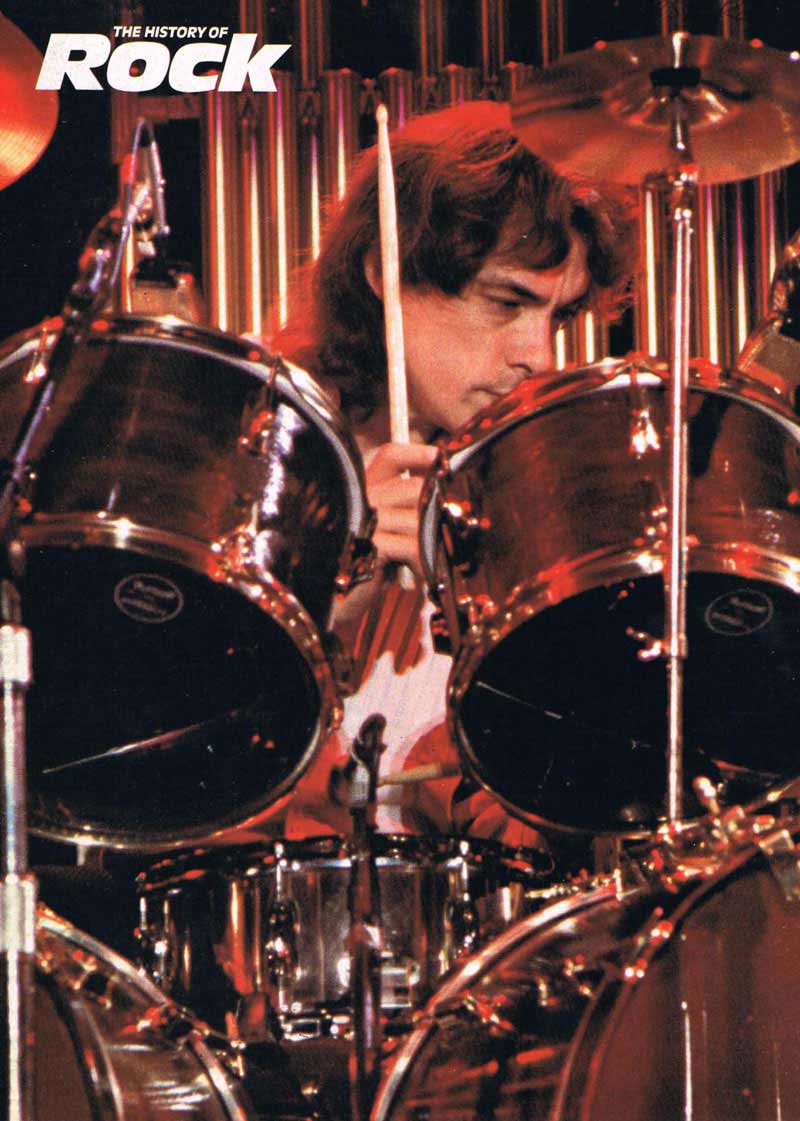
Neil Peart is one of rock's finest show drummers, whose uncompromising personality matches his single-minded dedication to music. As one-third of Canada's Rush, Neil made a tremendous contribution to their success, replacing original drummer John Rutsey in 1974. He not only brought considerable power to the percussion department, but he also gave the band a new sense of direction.
That Peart's reputation grew relatively slowly over the years may be explained by his association with a band wrongly labeled 'heavy metal' and therefore largely ignored by critics and the rock-music establishment. Audiences were quicker to appreciate their sophistication and skill, however, and it could be said that Rush in the Eighties were closer to the Police than anything resembling heavy metal, although their music remained firmly in the rock tradition.
Although Neil Peart has proved unwilling to talk about his background or even his drumming apprenticeship, it is obvious that he is a well-trained, practised drummer who has listened hard to many styles. A thorough study of rudiments, meanwhile, gave him complete mastery of his kit. He has stated that he learned his craft by listening to big band, progressive jazz, R&B, jazz-rock, pop, reggae, session and even 'lousy' drummers. 'I am none of them but I am all of them,' he said. Giving advice to aspiring young drummers, he states: 'Don't copy one drummer, copy twenty!'
Rush's music was also influenced by diverse groups during its evolution, including Deep Purple, Led Zeppelin and Yes, but the melodic and tightly conceived riffs providing the backbone of songs like 'The Spirit Of Radio' from Permanent Waves (1980) - arranged and executed in such a way that suggested some form of telepathy between the three players - attest to the power and originality of their later work. Much of the flexibility and variety is encouraged and enhanced by Neil's sensitive, probing drums. He manages to lay down the required heavy beat while punching out the guitar themes like a jazz big-band drummer enhancing a brass section.
He sits behind a kit that includes double bass drums, a dozen or more tom toms, a gong, tympani and other tuned percussion and a set of tubular bells. He employs a great mass of cymbals from the largest 22-inch crash and ride cymbals to tiny ten-inch diameter 'splashes'. With the aid of careful tuning, and by placing all his instruments within easy reach, he is able to construct drum solos that sound like a musical call to arms. He whirls around the kit, producing earthshaking thuds at furious speed on the bass drum while simultaneously crashing cymbals 'choked' by hand to obtain a backfiring effect.
A typical example of a Peart drum exhibition is to be found on the track 'YYZ', a concert favourite that appeared on Rush's live album Exit...Stage Left, released in 1981. After a typically sombre guitar riff from Alex Lifeson during which Neil takes the tempo at a brisk gallop, he launches into a solo that takes off on a tightly-stretched snare drum for several bars before bringing in his bass drum and choked cymbals. The effect is like that of a man being thrown over a cliff and somersaulting before hitting the rocks below.
Neil picks himself up without any apparent damage and rolls on around his small tom toms, playing a military tattoo before dropping into a double bass drum roll, continuing his melodic inventions on a set of cowbells. Accelerating slightly, he concludes the solo with a fierce barrage on the floor toms.
A relatively short piece of drum improvisation built around definite, pre-planned 'route markers', it never loses the piece's essential drive. Many drummers in similar circumstances play too long and get lost, or seem to lack any sense of purpose beyond getting to the end with a grand flourish. Peart's solos sustain interest throughout and have a compact feeling that exudes confidence.
There are many more examples of Peart's subtle drumming to be found on the many albums the trio released over ten years. His drumming constantly adds expression to Lifeson's guitar lines, another example being the Eastern temple-bell effects used on 'A Passage To Bangkok' from the 1976 album 2112 or the triangle sound followed by churchy tubular bells on the Genesis-influenced number 'Closer To The Heart' from the LP A Farewell To Kings (1977).
When confining himself to the basic snare, tom tom and bass drums, Neil's style is to pace the band like a gymnast, never flagging, offering encouragement, filling in with well-chosen licks but never seeking to impede the main runners, bassist Geddy Lee and guitarist Lifeson. He is, in short, a superb band drummer who has inspired a new, thoughtful generation of rock players.
Master Plans For Tomorrow's World
By Brian Harrigan
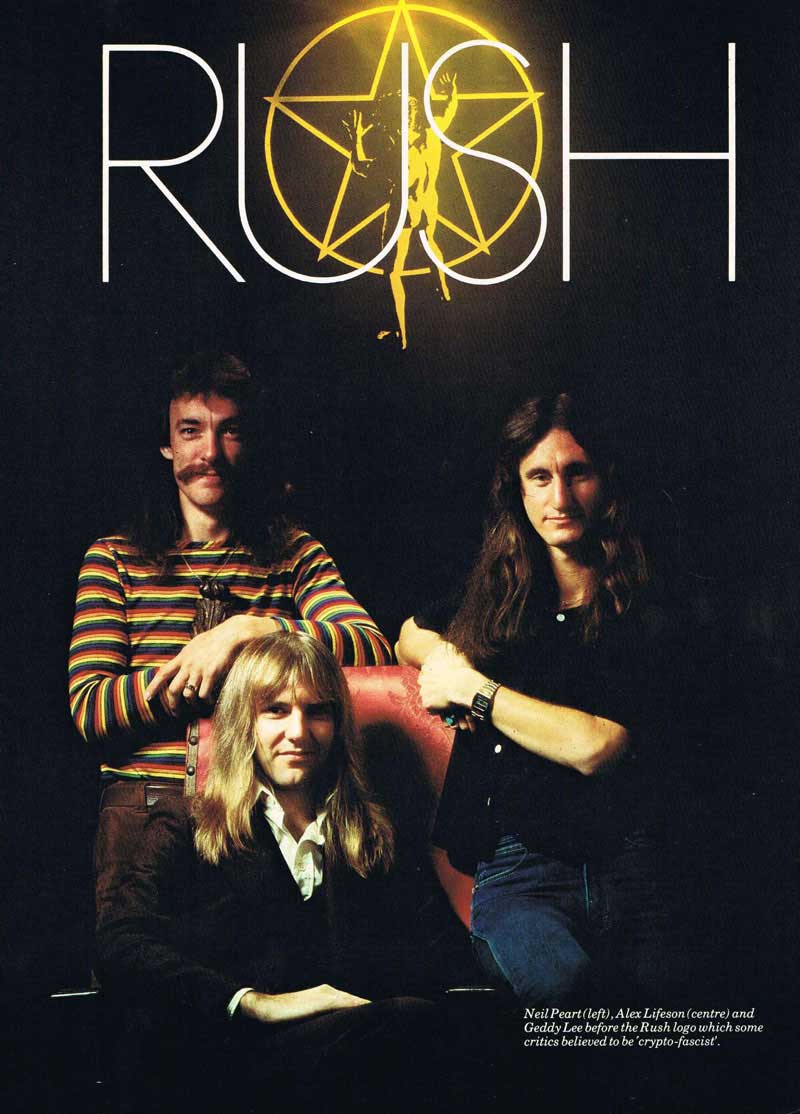
RUSH HAVE BEEN described as a poor imitation of groups as diverse as Black Sabbath, King Crimson, Grand Funk Railroad and Yes. They have been branded as crypto-fascists and, in one memorable turn of phrase, Paul Du Noyer of New Musical Express described their lyrics and philosophy as 'an ill-argued dog's dinner of Plato, Milton Friedman and Patience Strong'. At the same time, Rush have been lauded as 'awe-inspiring', 'the very best in their genre', 'expert, awesome, energetic and aware', 'members of an elite circle at the pinnacle of international rock' and 'one of the foremost musical forces and performing ensembles in the world'.
High-school rock
Founder members Geddy Lee (vocals, bass guitar, keyboards) and Alex Lifeson (lead guitar) met at school in Sarnia, a small township in the Canadian province of Ontario a couple of hundred miles from Toronto. Lee was born in Willowdale in the same province, while Lifeson came from Fernie in British Columbia. Together with drummer John Rutsey they formed a band at high school, singing songs by bands such as Grand Funk Railroad, the Jimi Hendrix Experience, Iron Butterfly and Cream. They played at school dances and private parties, graduating at the start of the Seventies to the bar and club circuit, which had been given a boost by new government legislation that lowered the legal drinking age from 21 to 18.
The band had earlier met up with a young promoter called Ray Danniels who had fixed them up with a gig in an Ontario school. When Danniels and his partner Vic Wilson got the chance to put the New York Dolls on at the Maple Leaf Gardens in Toronto in 1973 they remembered Rush and added them as support act.
Despite being daunted by the large audience, Rush went down well and decided to capitalise on this success by recording an album. Danniels and Wilson raised the money for the studio time and employed a local producer for the sessions, but the results were disastrous and Rush and their managers decided to bring in Terry Brown, who could boast extensive production experience with groups like April Wine, Thundermug and Procol Harum. Brown and Rush went into the Toronto Sound Studios and spent 9000 dollars on studio time, emerging with an infinitely better product.
Despite all their efforts, no record company would sign the group, so Rush and their managers decided to release their LP, Rush (1974), on their own label, which they called Moon Records. The album was available only in and around Toronto, but the first pressings sold out quickly due to the band's reputation as a hard-rocking live act.
Then came one of those lucky strokes of fate that most successful bands can boast of in their history. A friend of the group sent a copy of Rush to Donna Halper, the musical director of radio station WMMS, Cleveland, Ohio. She was so impressed by both the record and the response from her listeners that she informed both Mercury Records and New York talent agency ATI of Rush's remarkable potential. Both organisations signed Rush up in the summer of 1974 - Mercury, no doubt, heartened by the success of another Canadian band they already had on their roster, Bachman Turner Overdrive. Rush earned a two-album deal from Mercury worth 200,000 dollars. By the end of the year Rush had sold 75,000 copies - not a bad achievement for a debut album from a Canadian band.
Return to fantasy
Within a month of the album's release, however, Rush were faced with the urgent problem of finding a replacement for John Rutsey in order to fulfill the dates of an extensive tour of the US arranged by ATI. He had been forced to quit the group because of ill-health brought on by the grueling touring schedules that Rush had set themselves since turning professional. After auditioning dozens of hopefuls, Lee and Lifeson eventually decided to enlist Neil Peart, whom they remembered from the Toronto club circuit.
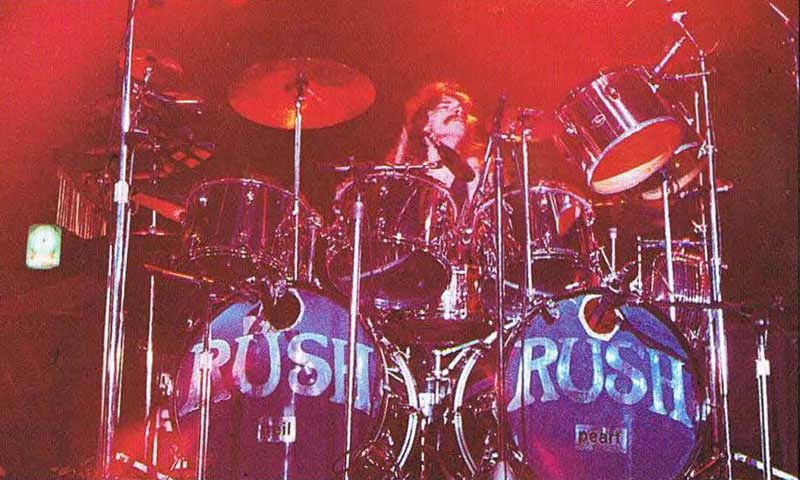
Peart was born and raised near Toronto. An extensive reader, he was particularly attracted to fantasy and science fiction, most notably by such authors as C. S. Lewis, J. R. R. Tolkien and the Russian-born, Canadian-naturalised Ayn Rand, who was to prove a prodigious influence on both Peart and Rush.
As a child Peart showed an interest in music, which his parents attempted to satisfy by sending him to piano lessons. Unfortunately the piano was not the instrument he had in mind, so they eventually ended up buying him a drum kit and 18 months' worth of lessons. Having played in high-school and club bands, Peart tried his luck in London, a city he considered as something of a musical home given his interest in drummers like Keith Moon, Carl Palmer, and Bill Bruford. Things did not work out for him there, however, and he was reduced to selling souvenirs on sleazy Carnaby Street. He eventually packed his bags and headed for home, where he finally joined Rush.
Rush's first tour of the US ran from the middle of August to just before December 1974, playing bills headed by such bands as Manfred Mann's Earth Band, Uriah Heep, Rory Gallagher and Blue Cheer. The reviews of Rush's concerts were mixed, but the band were undismayed. Their debut LP had proved to be Mercury's biggest-selling first album by a Canadian group; this fact encouraged them to return to the studios in January 1975 to work on a follow-up.
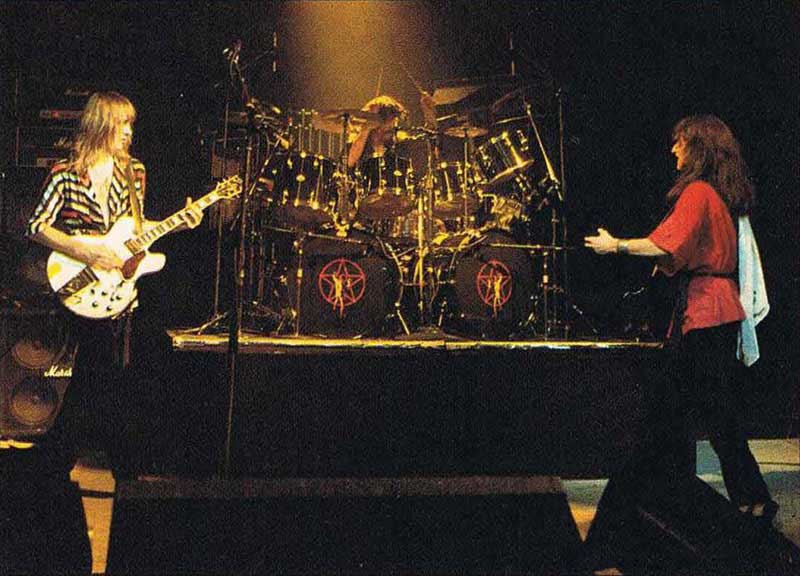
At this point Peart revealed that the band had got much more than a talented percussionist when they signed him up. He proved to be a gifted ideas man and a hardworking lyricist. The band's second album, Fly By Night, immediately showed Peart's influence, featuring tracks with epic or mythological themes, such as 'By-Tor And The Snow Dog', 'Rivendell' (the name of a village in Tolkien's Lord Of The Rings) and the notorious 'Anthem', inspired by Ayn Rand's 1938 novel of the same name.
The last-named song became notorious because Ms Rand was considered by some to be something of a fascist in her views. With its emphasis on free will, personal responsibility and dislike of socialism, 'Anthem' and a number of similar songs were to earn Rush the title of 'crypto-fascists' from some left-wing music critics in the late Seventies. Peart has vehemently and repeatedly denied any such leanings: 'I'm not a fascist or an extremist. I'm a capitalist and I believe in self-reliance - that's all.'
Fly By Night was rapidly completed, being released in February 1975. At the same time, Rush won a Juno Award, Canada's equivalent to the Grammy, for being the country's most promising new group. With the album selling well and the Juno award on their mantelpiece, Rush embarked on their second US tour, supporting Kiss and Aerosmith.
They then went back into the studios in Toronto to work on their third album, Caress Of Steel (1975). While the album included a nonsense song called 'I Think I'm Going Bald', a melodic gem entitled 'Lakeside Park', and a further installment in the legend of By-Tor in 'Necromancer', its most important feature was that the whole of one side was devoted to 'The Fountain Of Lamneth'. This epic track combined all of Peart's influences and ideas in a single glorious outpouring. With hindsight, 'The Fountain Of Lamneth' now seems overstuffed with themes and allegories, but at the time it underlined the fact that Rush were considerably more than just another heavy-metal band.
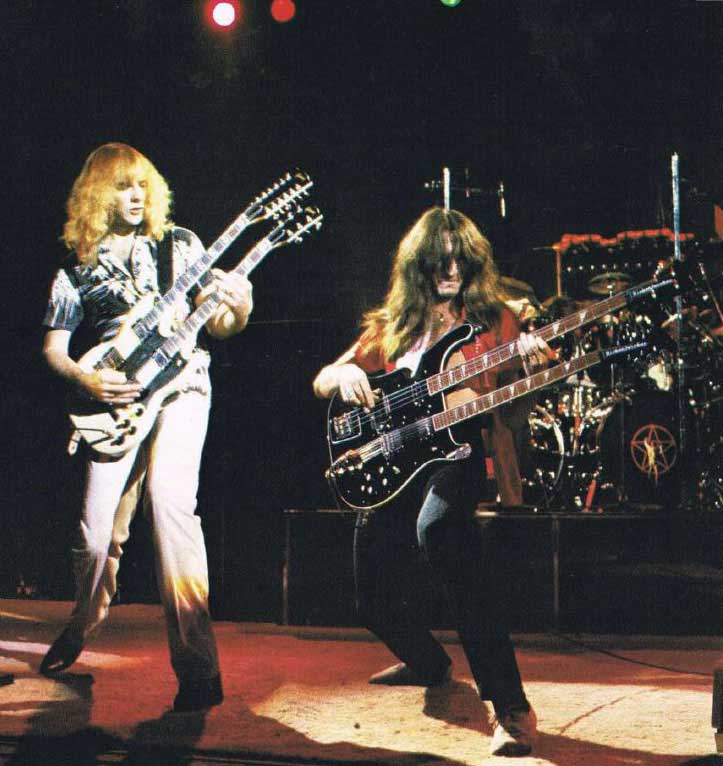
By the end of March 1976 Fly By Night had gone gold in Canada, while in the same country Caress Of Steel had sold 40,000 copies - a fine achievement since it had been released only the previous September. Heartened by the success of both albums, Rush decided to be even more ambitious with their next release. It was left to Peart to come up with the subject-matter and, once again, he turned to Ayn Rand and her novel Anthem. He concentrated on the lyrics, while Lee and Lifeson worked together on the music. The material took six months to compile and a month to record - the result was 2112.
Released in late 1976, the album concerned the battle of an individual against a world run by the despotic Priests of the Temple of Syrinx, where society was governed by logic and anything illogical - including music - was outlawed.
Rush's portrayal of this totalitarian state infuriated some critics, who were also quick to read special significance into Rush's logo - a naked man fending off a red star. Peart and Rush remained unperturbed, however, considering 2112 the culmination of their achievements. Admitting that the album had exhausted them of ideas, the band came up with a live album for their next release. It was called All The World's A Stage, recorded at Toronto's Massey Hall and released in the autumn of 1976.
Rush through time
Both 2112 and All The World's A Stage established Rush as a major band in the US and also initiated their acceptance in the UK. Their growing transatlantic popularity was cemented in the middle of 1977 when they played their first dates in Britain and Europe. Earlier in the year, they had come to Britain to record A Farewell To Kings (1977) in Rockfield Studios in Wales.
Previous Rush albums had been available in the UK only on a limited-edition import policy adopted by Phonogram, the company that handled Mercury's releases there. Rush's British sales figures had eventually proved sufficiently heartening for A Farewell To Kings to be officially released in the UK, and the group's previous albums subsequently saw belated release. Rush's stature increased with the release of each of their subsequent LPs -Hemispheres (1978), Permanent Waves (1980), Moving Pictures (1981), their second live album Exit...Stage Left (1981) and Signals (1982).
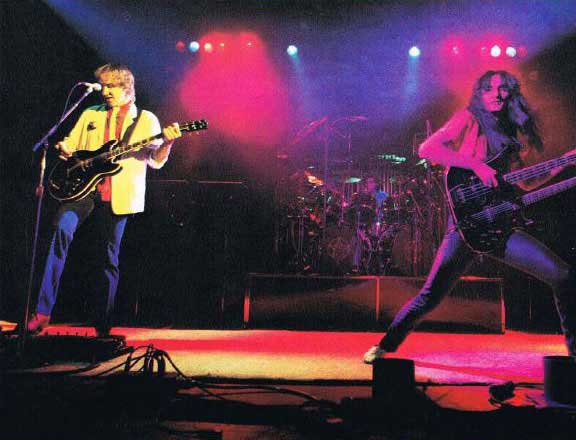
There were no dramatic line-up changes in the band after Peart joined, nor any dramatic announcements about a change of approach or direction either on stage or on record. Instead, Rush pursued a policy of gradual development that culminated with the release of Signals, a marvelous collection of hugely disparate elements -everything from hints of Peart's old sword-and-sorcery confections to reggae.
Their popularity in the UK at the end of 1982 was such that they were able to draw capacity audiences for two nights at the enormous National Exhibition Centre in Birmingham and three nights at London's Wembley Arena. Geddy Lee commented at the time: 'I don't think when we entered this thing that we considered we'd have anything which could be described as a short career. However, we also have no intention of playing the same kind of music over and over again for year after year.
'It's been a long time since we could have been considered a heavy-meta) band, if ever. And it's just as long since we could have been called a "pomp-rock" band or a "progressive band" or whatever. We are our own men with our own tastes. We have dozens of interests and influences and we intend to show them for a long time to come.'
Rush
Recommended Listening
Rush Through Time (Mercury 6337 171) (Includes: Fly By Night, Anthem, Closer To The Heart, Bastille Day, Overture/Temples Of Syrinx, Something For Nothing); Exit...Stage Left (Mercury 6619 053) (Includes: The Spirit Of Radio, YYZ, The Trees, Tom Sawyer, A Passage To Bangkok, La Ville Strangiato). 2235